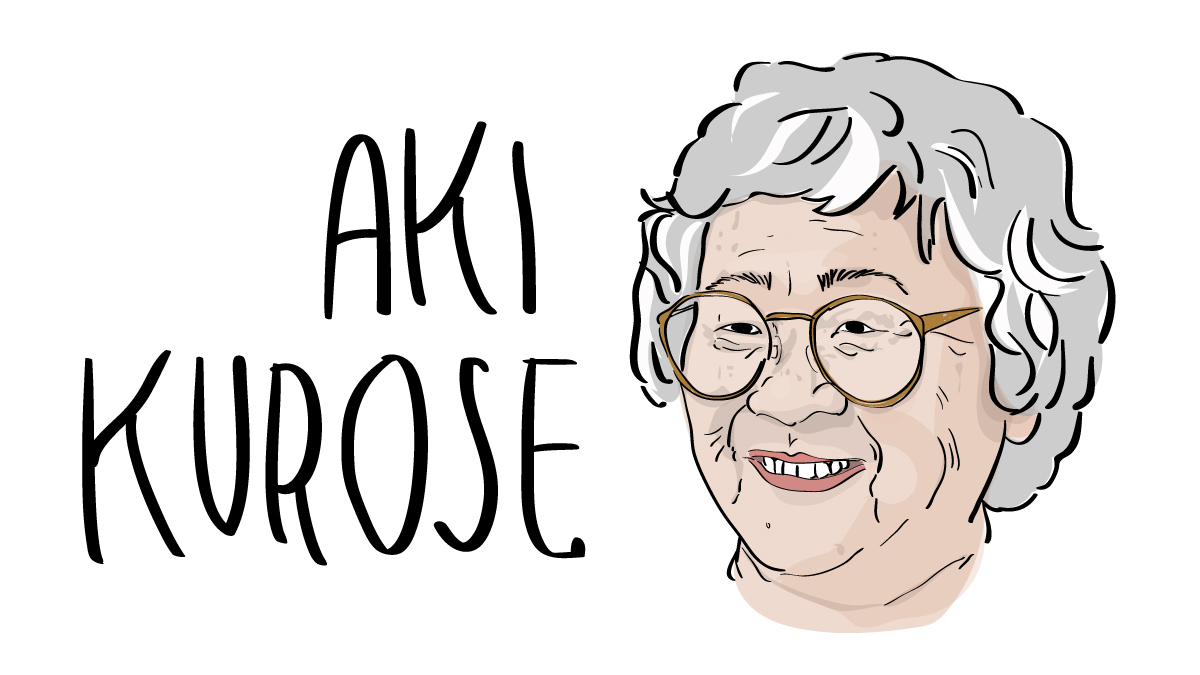
In celebration of Asian American, Native Hawaiian, and Pacific Islander (AANHPI) Heritage Month, we are hosting a series of profiles and stories to amplify and honor people, businesses, organizations, and projects connected to the history of Seattle’s AANHPI community.
“Always realize that not to get involved when you should get involved is an act of violence. You should always work for peace…Peace is the most empowering and productive way to go.”
Aki Kurose
Aki Kurose spent her life advocating for peace and social justice. As a teacher and an activist, she worked tirelessly to improve housing, education, and civil rights for Seattle’s communities of color. Her unwavering commitment to peace and equity was instilled by her parents in early childhood, strengthened and tested through her family’s incarceration during World War II, and fully realized in her work as an elementary school teacher and housing advocate.
Born in Seattle in 1925 to Harutoshi and Murako Kato, two Japanese immigrants, Kurose was raised in the Central District where her mother ran an apartment building. Her neighbors included Black, Jewish, Chinese American, and Japanese American families. This multicultural upbringing and her parents’ deep commitment to inclusivity had a profound impact on her worldview. Her home was constantly filled with people from diverse backgrounds and her family embraced and celebrated various cultural traditions.
Everything changed for Kurose during her senior year at Garfield High School with the bombing of Pearl Harbor. In February of 1942, President Franklin Roosevelt issued Executive Order 9066 which cleared the way for the incarceration of Japanese Americans. Kurose’s family was first sent to a temporary camp at the Puyallup Fairgrounds and later to the Minidoka internment camp in Idaho. The multicultural and vibrant life that Kurose had become accustomed to suddenly became very homogenous. But she persevered at Minidoka, finishing her education and getting involved with the American Friends Service Committee (AFSC), a Quaker organization working for peace and social justice in the United States and around the world.

After the war, Kurose attended college and married Junelow (Junks) Kurose. After the birth of their first child, the couple moved back to Seattle where they struggled to find a home due to discriminatory housing practices. This influenced Kurose to become involved in the open housing movement of the 1950s, eventually leading her to join the Congress of Racial Equality (CORE), a civil rights organization which campaigned for, among other things, Black employment and fair housing.
The Kurose’s had a total of six children and Aki made sure they were immersed in civil rights efforts. She enrolled them in Seattle’s Freedom School and regularly took them to civil rights marches and anti-war demonstrations. During this time, she also began taking classes in early childhood education and working in preschool programs. Along with a group of neighborhood parents, she helped create Seattle’s first Head Start program in the mid-sixties, and began teaching for Seattle Public Schools in 1974.
The beginning of Kurose’s teaching career coincided with the federally mandated desegregation of Seattle’s schools. She was transferred from MLK Elementary, a predominantly Black school in South Seattle, to Laurelhurst Elementary, which had been an exclusively white school in North Seattle. She was immediately faced with discrimination and was required to defend her qualifications and be monitored in the classroom by parents.
But, Kurose took it all in stride, eventually winning the respect and admiration of her new school community. She also advocated for the students of color who began being bussed to Laurelhurst in 1978. She helped ease their integration and worked with her colleagues to ensure they had a multicultural curriculum that better represented and served these new students.
Her innovative teaching style leaned heavily on cooperative work, experiential learning, and peace advocacy, and earned her many accolades and awards. She was named Seattle Teacher of the Year in 1985 and awarded the Presidential Award for Excellence in Science and Mathematics in 1990. In 1980, Kurose was appointed to Jimmy Carter’s National Advisory Council on the Education of Disadvantaged Children, and in 1992 she was awarded the United Nations Human Rights Award.
Aki Kurose died on May 24, 1998, after a 16-year long battle with cancer. She was 73.

Her legacy lives on today through various namesakes in Seattle. Upon her retirement in 1997, Laurelhurst Elementary students and parents dedicated the Aki Kurose Peace Garden on the school grounds. Aki Kurose Village, a family-friendly affordable housing community in North Seattle, opened in 1999, and in 2000 the Casper W. Sharples Junior High was renamed the Aki Kurose Middle School Academy, the first Seattle school named after an Asian American woman.
Learn more about Aki Kurose in this Densho interview from 1997.


